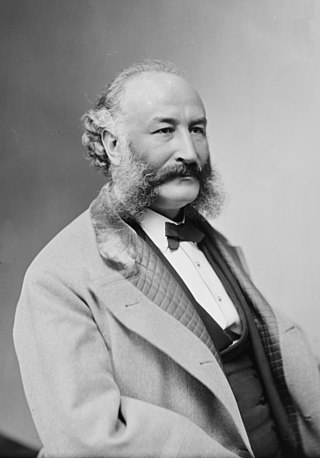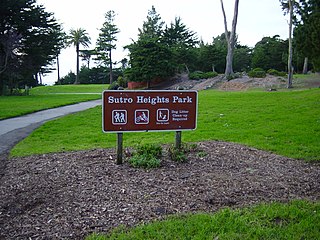
Nevada County is a county located in the U.S. state of California, in the Sierra Nevada. As of the 2020 census, the population was 102,241. The county seat is Nevada City. Nevada County comprises the Truckee-Grass Valley, CA Micropolitan Statistical Area, which is also included in the Sacramento-Roseville, CA Combined Statistical Area, part of the Mother Lode Country.

James Graham Fair was an Irish immigrant to the United States who became a highly successful mining engineer and businessman. His investments in silver mines in Nevada made him a millionaire, and he was one of the famous "silver kings" who became wealthy on the Comstock Lode. Fair later became a real estate investor and railroad builder in California. In 1881, he was elected a United States Senator from Nevada. Nearly all other major so-called robber barons were Protestants while Fair himself was a Roman Catholic born into poverty.

Virginia City is a census-designated place (CDP) that is the county seat of Storey County, Nevada, and the largest community in the county. The city is a part of the Reno–Sparks Metropolitan Statistical Area.

The Comstock Lode is a lode of silver ore located under the eastern slope of Mount Davidson, a peak in the Virginia Range in Virginia City, Nevada, which was the first major discovery of silver ore in the United States and named after American miner Henry Comstock.

Adolph Heinrich Joseph Sutro was a German-American engineer, politician and philanthropist who served as the 24th mayor of San Francisco from 1895 until 1897. Born a German Jew, he moved to Virginia City, Nevada and made a fortune at the Comstock Lode. Several places in San Francisco bear his name in remembrance of his life and contributions to the city.

William "Billy" Chapman Ralston was a San Francisco businessman and financier, and the founder of the Bank of California.

Sutro Heights Park is an historic public park in the Outer Richmond District of western San Francisco, California. It is within the Golden Gate National Recreation Area and the Sutro Historic District.

Silver City is a Census Designated Place and small residential community in Lyon County, Nevada, USA, near the Lyon/Carson border. The population as of the 2000 census was 170.

Gold Hill is an unincorporated community in Storey County, Nevada, located just south and downhill of Virginia City. Incorporated December 17, 1862, in order to prevent its annexation by its larger neighbor, the town at one point was home to at least 8,000 residents. Prosperity was sustained for a period of 20 years between 1868 and 1888 by mining the Comstock Lode, a major deposit of gold and silver ore. Mines such as the Yellow Jacket, Crown Point, and Belcher brought in over $10 million each in dividends. Historical remnants of the town can still be seen, including the Gold Hill Hotel, promoted as Nevada's oldest hotel, in existence since 1861; the former Bank of California building; the restored Virginia & Truckee Railroad depot; the Depression-Era Crown Point Mill; and remains of several of the mines and residences in various states of restoration and repair.

The Sutro Tunnel is a drainage tunnel (adit) connected to the Comstock Lode in Northern Nevada. It begins at Dayton, Nevada and connects 3.88 miles (6.24 km) Northwest to the Savage mine in Virginia City, Nevada. The Sutro Tunnel pioneered the excavation of large drainage and access tunnels in the US. Later US mine drainage tunnels included the Argo Tunnel at Idaho Springs, Colorado, the Leadville and Yak tunnels at Leadville, Colorado, and the Roosevelt tunnel in the Cripple Creek district, Colorado.
Silver mining in Nevada, a state of the United States, began in 1858 with the discovery of the Comstock Lode, the first major silver-mining district in the United States. Nevada calls itself the "Silver State." Nevada is the nation's second-largest producer of silver, after Alaska. In 2014 Nevada produced 10.93 million troy ounces of silver, of which 6.74 million ounces were as a byproduct of the mining of gold. The largest byproducers were the Hycroft Mine, the Phoenix Mine, the Midas Mine and Round Mountain.
Vernon was a small mining town, now a ghost town, located in Pershing County, Nevada northwest of Lovelock.
Poeville, also known as Peavine until 1863, is the site of a historical mining town, established in 1864. John Poe, a professional promoter from Michigan allegedly related to Edgar Allan Poe, discovered rich gold and silver veins in 1862 on the slopes of Peavine Mountain. After the discovery of ore, Poe announced that the veins comprised the next Comstock Lode; he presented extracted ore at the state fair of 1864 as rich in content. As a result, the former mining camp, called Poe City (Poeville) or Podunk (Poedunk), grew to 200 people by 1864. Ore production in the mining district and population peaked around 1873-1874 with several hundred people living in town, supported by three hotels and a post office. The post office, named "Poeville", operated between September 1, 1874, and March 24, 1878.
Mooney Flat was an important mining and transportation hub in western Nevada County, California, just east of the Yuba County line. It was situated on modern Mooney Flat Road, about 1 mile north of modern Highway 20, at an elevation of about 800 ft.
Remington Hill is a historic mining camp in Nevada County, California which prospered in the second half of the 19th century. It was named for Caleb Remington, a prominent local miner who lived mostly in neighboring Little York, where he died in 1865. It lay at an elevation of 4052 feet. It was situated around present Chalk Bluff Road about one mile south of Highway 20 and about 5.5 miles southeast of the town of Washington and 6 miles northeast of Dutch Flat, as the crow flies.
Schellbourne, formerly known as Fort Schellbourne and Schell Creek Station is a ghost town located in the Schell Creek Range in White Pine County in Nevada, United States, located 43 miles (69 km) north of Ely. The town was a stopover along the Central Overland Route, Pony Express and original routing of the Lincoln Highway. It is today Nevada Historical Marker number 51. The site was listed on the National Register of Historic Places in 1972. Its boundaries were increased in 1977.

El Dorado Canyon is a canyon in southern Clark County, Nevada famed for its rich silver and gold mines. The canyon was named in 1857 by steamboat entrepreneur Captain George Alonzo Johnson when gold and silver was discovered here. It drains into the Colorado River at the former site of Nelson's Landing.
Rhodes, Nevada is a former rail station and Post Office on the Carson and Colorado Railway in Mineral County, Nevada.
Hardin City was the site of a Nevada silver mining boom town from 1859 until about 1868. Hardin City was located on the western slope of the Black Rock Range in the Black Rock Desert.

The Sutro Library is a branch of the California State Library located in San Francisco on the campus of San Francisco State University. The foundation of the library's collection was assembled by former San Francisco mayor, engineer, entrepreneur, and philanthropist Adolph Sutro. The library was deeded to the State of California by Sutro's heirs with the stipulation that it never leave the city limits of San Francisco, filling his desire to provide the city with a public research library. It was formally given to California State Library in 1913, and opened to the public in 1917. Notably, half of the Sutro collection survived the "Great Fire" after the San Francisco earthquake of 1906. Collection highlights include 125,000 rare books, antiquarian maps, and archival collections, as well as a genealogical library.
















